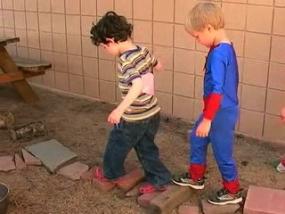To Make a Path of Stones

The six children in this video have just finished creating a sculpture on the playground. They turn their attention to making a pathway that will lead to their sculpture. One boy begins to move a large patio block, then realizes that he can lift only one side. He asks, “Can anybody help me?” and a girl quickly volunteers. The boy sets the sculpture as the starting point for laying their path while the girl says, “We need to go from the door”. Another boy invents a different strategy to move a large block; he drags it to a new location. The children search for additional materials to make the path. Observe how the children take into account the shape, size and type of material in deciding where to place the material. Speculate on why the children include or exclude certain items. For example, the girl removes two objects from the path and says, “These ones are out because they’re too little”. The teacher wants to better understand the child’s thinking so she encourages the girl to explain further by asking, “What’s too small? Too small for a bird? Too small for a worm? Too small for a person?” We learn that the girl is thinking about the relationship between size and function as she replies, “It’s too small for my feet” and demonstrates by placing her foot on the little stone. When the children think that their path may be complete they decide to give it a try. They treat the doorway, rather than their sculpture, as the starting point for their path. The girl observes as the boys begin to walk along and she announces, “Our path is finished”. Perhaps for her the path is finished if it is used. One boy says, “We made it to our sculpture”. For the boy, the path is finished when they can successfully reach the end. Another child says, “So who wants to check it out?” For him, perhaps, the entire walk needs to be evaluated before they can rest. The teacher decides to accept the boy’s invitation to evaluate the full functionality of the path. At one point she and one of the children meet, and the teacher says, “I will step to the side and let you pass my friend. and then I will come back and continue”. Might the teacher have said this to cause the children to think about the width of the path? Can you think of other ways to encourage children to think about the completeness and functionality of their path? Perhaps we could consider making a larger path and see if the children would form teams or assign differentiated tasks. One can see that the large scale of the project, the clarity of its purpose, and the ease with which the products can be laid and modified make path building an activity suitable for collaboration, planning and reflection. When the children think that their path may be complete so they decide to give it a try. They treat the doorway, rather than their sculpture, as the starting point for their path. The girl observes as the boys begin to walk along and she announces, “Our path is finished”. Perhaps for her the path is finished if it is used. One boy says, “We made it to our sculpture”. For the boy, the path is finished when they can successfully reach the end. Another child says, “So who wants to check it out?” For him, perhaps, the entire walk needs to be evaluated before they can rest. The teacher decides to accept the boy's invitation to evaluate the full functionality of the path. At one point she and one of the children meet, and the teacher says, “I will step to the side and let you pass my friend and then I will come back and continue”. Might the teacher have said this to cause the children to think about the width of the path? Can you think of other ways to encourage children to think about the completeness and functionality of their path. Or perhaps we should consider making a larger path and see if the children would form teams or assigned differentiated tasks. One can see that the large scale of the project, the clarity of its purpose, and the ease at which the products can be laid and modified make path building an activity suitable for collaboration, planning and reflection.
Length of stand-alone master video clip: 4 minutes 22 seconds
Highlight the text above and paste to a document to have your own copy.
Keywords: Fives, Children-Teacher, Teaching, Spatial Relations, Collaboration
